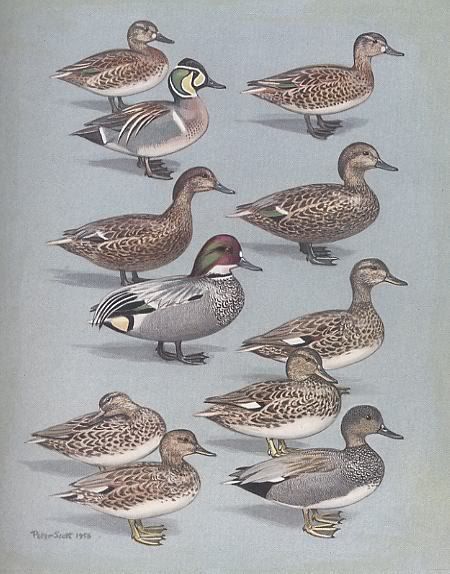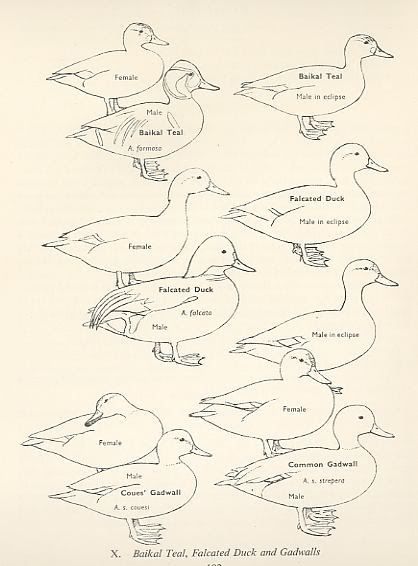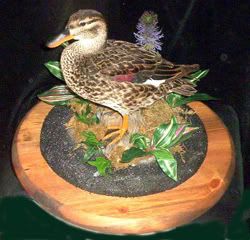|
|
Post by sebbe67 on Jan 30, 2005 22:04:15 GMT
here is some more information about this of gadwall
The wetlands of Teraina are the only known locality for Coue's Gadwall (Anas strepera couesi). The two type specimens of this small, dark race of the Gadwall were collected on Teraina in 1874. The duck has not been found again, and is presumed to have become extinct during the early years of settlement.
|
|
|
|
Post by Melanie on Oct 14, 2006 23:56:30 GMT
Well, it seems that this subspecies is invalid today and that the Coues's Gadwall was nothing more than juveniles of the Common Gadwall which were drifted to Washington Island (translated from here: de.wikipedia.org/wiki/Schnatterente ). |
|
|
|
Post by Melanie on Oct 15, 2006 1:16:29 GMT
The Coues Gadwall Extinct.-In the Bulletin of the Nuttall Ornithological Club for
1876. D. 46. Dr. T. H. Streets described a native duck from Washinaton Island. in the
Fanning group, under the name Chaulelasmus couesi. The following year,’ in the
American Naturalist for 1877, p. 68, Streets relates that when he visited Washington
Island in 18’74 “the lake and peat-bogs were tenanted by a diminutive species of duck
of the genus Chaulelasmus.” These apparently are the only first-hand observations on
this species that have been published, since Phillips, in his Natural History of the
Ducks, vol. 2, 1923, p. 158, states that he has found no further record of the bird.
During work in the Pacific, in 1923, I had associated with me for a period of
several weeks Mr. W. G. Anderson of Honolulu who was born about thirty years ago
on Fanning Island, near the equator south of Hawaii, and who spent his boyhood and
youth on that island and on Washington about eighty miles distant. He informs me
that migrant ducks come to Fanning and Washington in considerable numbers from
November to March each year, and that their hunting is a regular sport. Anderson
is thoroughly familiar with the lake and peat bog on Washington Island, so that such
a curiosity as a resident duck would certainly have come under observation. During
all of his years of residence, however, he knew nothing of the native Gadwall, so that
the species must have been extinct for many years.
The only specimens preserved are the two taken by Streets (now in the U. S.
National Museum), and our only knowledge of its habits is the brief note by Streets in
the American Naturalist. The species was probably exterminated by settlers who did
not recognize it as distinct from other ducks encountered as migrants.-ALEXANDER
WETMORE, National Zoological Park, Washington, D. C., November 26, I%%$.
|
|
|
|
Post by dysmorodrepanis on Oct 29, 2006 21:52:11 GMT
Well, it seems that this subspecies is invalid today and that the Coues's Gadwall was nothing more than juveniles of the Common Gadwall which were drifted to Washington Island (translated from here: de.wikipedia.org/wiki/Schnatterente ). I know - I think I know where it comes from, till try to dig up & add on EN:WP |
|
|
|
Post by Melanie on Nov 22, 2006 3:20:38 GMT
If you have locked this tread for a later delition i would suggest to let remain this thread here, because even if its invalid it is mentioned in so many books.
|
|
|
|
Post by another specialist on Nov 22, 2006 15:09:30 GMT
I agree with you Melanie if its now classed as invalid or its just becames a population it still has a right to remain as classifications always change.
There have been many cases that a valid species gets declassified for some reason then it gets reclassified as valid again.
|
|
|
|
Post by another specialist on Jul 24, 2007 19:56:27 GMT
Baikal Teal, Falcated Duck & Gadwalls with Color Plate & Matching Species Key Baikal Teal, Falcated Duck , Coues' Gadwall, Common Gadwall  Species Key;  mawba.com/baikal.htm mawba.com/baikal.htm  |
|
|
|
Post by another specialist on May 3, 2009 19:08:05 GMT
 Encyclopaedia of Birds By Arvind N. Shukla, Rajiv Tyagi |
|
|
|
Post by another specialist on May 3, 2009 19:11:25 GMT
Coues' Gadwall or Washington Island Gadwall (Anas strepera couesi) is an extinct dabbling duck which is only known by two immature specimens from the Pacific island of Teraina (formerly known as Washington Island -- Luther mentions a supposed occurrence on "New York Island", which is merely another old name of Teraina however)Line Islands, Kiribati[1] . They are in the National Museum of Natural History in Washington, D.C.[1]. The bird was named in honor of Elliott Coues. A male and a female are known, which resemble the immature appearance of the Common Gadwall except for the black bill with a higher number of fuiltering lamellae, black feet, and the much inferior size (which may be due to the birds not being fully grown). The male resembles a male Common Gadwall in eclipse plumage save for some white speckling on the breast and back. The female looks like a small Common Gadwall female; the primary wing coverts were not patterned black, and the inner web of the secondary remiges was grey instead of white.[2][3][1] Measurements are: wing, 199 mm; bill, 37 mm; tarsus 36 mm[1]. This means the birds were the size of a Cape Teal or Garganey, with a total length of 40-45 cm[4]. As the birds were not fully adult when shot, it is not clear whether they would not have grown a bit larger. Status and extinction The status of this bird is controversial. While many scientists consider it as dwarfed subspecies of the Common Gadwall (Anas strepera strepera)[5] others argue that the two individuals might have been just juveniles of a local breeding population that might not even be taxonomically distinct. The Common Gadwall is a known vagrant to the Tuamotu Islands(Kolbe wrote "Tahiti which is a misreading of Greenway)[6] and Hawaiʻi for example, which are about the same distance from the species' breeding grounds as is Teraina (which moreover lies in between these two groups). This makes it entirely possible that the Washington Island gadwalls were just the offspring of a few vagrant Common Gadwalls, maybe settling after being wounded by hunters[2][6][1]. On the other hand, Streets' reports suggest that there was a population of these ducks of some size present, and thus they may have lived there since quite some time and indeed be worthy of recognition as a distinct taxon[7]. The observations of the two individuals took place in January 1874[8]. The species' description was by Thomas Hale Streets (1847–1925) in 1876. Streets reported about the two immatures he shot and which were found in a peat bog.[7] The cause of its extinction might be the extensive hunting by settlers of Tabuaeran (Fanning Island) which have shot large numbers of migrant ducks on both Teraina and Tabuaeran each year. W.G. Anderson, a local resident stated in 1926 that growing up on Teraina and Tabueran around the turn of the century, he had never encountered a native population of gadwalls on Teraina. Thus, the population's disappearance can be fixed to the last quarter of the 19th century, between the mid-1870s and 1900.[7] 1.^ a b c d e Luther, D. (1996) 2.^ a b Greenway, J. (1967) 3.^ Day, D. (1981) 4.^ Madge & Burn (1987) 5.^ E.g. Carboneras (1992) 6.^ a b Kolbe, D. (1984) 7.^ a b c Wetmore, A. (1925) 8.^ Bulletin - United States National Museum (1877) (description as Chaulelasmus couesi). United States National Museum; Smithsonian Institution; United States. Dept. of the Interior Carboneras, Carles (1992): 74. Gadwall. In: del Hoyo, Josep; Elliott, Andrew & Sargatal, Jordi (eds.): Handbook of Birds of the World (Volume 1: Ostrich to Ducks): 602, plate 45. Lynx Edicions, Barcelona. ISBN 84-87334-10-5 Day, David (1981): The Doomsday Book of Animals. Ebury, London/Viking, New York. ISBN 0-670-27987-0 Fuller, Errol (2000): Extinct Birds (2nd ed.). Oxford University Press, Oxford, New York. ISBN 0198508379 Greenway, James C. Jr. (1967): Washington Island Gadwall. In: Extinct and Vanishing Birds of the World (2nd ed.): 171-172. Dover Publications, New York. Kolbe, Dieter (1984): Die Entenvögel der Welt (3rd ed.). [in German] J. Neumann-Neudamm, Melsungen. ISBN 3-7888-0424-6 Luther, Dieter (1996): Coues' Schnatterente ["Coues' Gadwall"]. In: Die ausgestorbenen Vögel der Welt (Die neue Brehm-Bücherei 424) (4th ed.): 27-28. [in German] Westarp-Wissenschaften, Magdeburg; Spektrum, Heidelberg. ISBN 3-89432-213-6 Madge, Steve & Burn, Hilary (1987): Wildfowl : an identification guide to the ducks, geese and swans of the world. Christopher Helm, London. ISBN 0-7470-2201-1 Wetmore, Alexander (1925): The Coues Gadwall Extinct. Condor 27(1): 36. PDF fulltext en.wikipedia.org/wiki/Coues%27_Gadwall |
|
|
|
Post by another specialist on May 3, 2009 19:12:18 GMT
The Coues Gadwall Extinct.-In the Bulletin of the Nuttall Ornithological Club for 1876. D. 46. Dr. T. H. Streets described a native duck from Washinaton Island. in the Fanning group, under the name Chaulelasmus couesi. The following year,’ in the American Naturalist for 1877, p. 68, Streets relates that when he visited Washington Island in 18’74 “the lake and peat-bogs were tenanted by a diminutive species of duck of the genus Chaulelasmus.” These apparently are the only first-hand observations on this species that have been published, since Phillips, in his Natural History of the Ducks, vol. 2, 1923, p. 158, states that he has found no further record of the bird. During work in the Pacific, in 1923, I had associated with me for a period of several weeks Mr. W. G. Anderson of Honolulu who was born about thirty years ago on Fanning Island, near the equator south of Hawaii, and who spent his boyhood and youth on that island and on Washington about eighty miles distant. He informs me that migrant ducks come to Fanning and Washington in considerable numbers from November to March each year, and that their hunting is a regular sport. Anderson is thoroughly familiar with the lake and peat bog on Washington Island, so that such a curiosity as a resident duck would certainly have come under observation. During all of his years of residence, however, he knew nothing of the native Gadwall, so that the species must have been extinct for many years. The only specimens preserved are the two taken by Streets (now in the U. S. National Museum), and our only knowledge of its habits is the brief note by Streets in the American Naturalist. The species was probably exterminated by settlers who did not recognize it as distinct from other ducks encountered as migrants.-ALEXANDER WETMORE, National Zoological Park, Washington, D. C., November 26, I%%$. |
|
|
|
Post by another specialist on May 3, 2009 19:16:37 GMT
This is bird scientifically classed as invalid?
From what I can find it's not confirmed and it still can be a valid subspecies.
It's still 50/50
|
|
|
|
Post by another specialist on May 3, 2009 20:14:27 GMT
 Coues Gadwall - (Anas Strepera couesi) - Also known as the Washington Island gadwall, this bird is a subspecies of the Gadwall that was only found on Washington and Line Islands. Only two specimens have ever been collected. They were collected around 1870, and since then no others have been found or reportedly seen. Coues Gadwall Recreation Images About the bird: The Coues’ Gadwall can best be described as a dwarf of their North American relative, the Gadwall. They were around the size of a teal, and their plumage closely resembled that of an immature Gadwall male. The sexes were similar in appearance. The main difference between the Coues’ Gadwall and the common Gadwall is the size, and the unique structure of their bill. They had many more lamellae “teeth” than the common Gadwall, and all of this was taking into consideration when recreating this very rare bird. Purchase this bird: Request the Coues Gadwall For the Coues’ gadwall I offer a male in breeding plumage on the appropriate habitat. Since the sexes were practically identical in plumage, the need for a pair is not warranted. Only two are known to exist, and that pair is not mounted. A mount of this bird is truly something that no one else in the world possesses, making this a truly unique trophy to own. Coues Gadwall Prices View Complete List Coues Gadwall Drake: $295 aliveagainrecreations.com/coues.php |
|
|
|
Post by Melanie on May 3, 2009 20:53:28 GMT
The HBW account regarded Anas strepera as monotypic. And the German Waterfowl specialist Hartmut Kolbe is sure that the two birds from Teraina are just juveniles of the Common Gadwall. This is bird scientifically classed as invalid? From what I can find it's not confirmed and it still can be a valid subspecies. It's still 50/50 |
|
|
|
Post by another specialist on May 4, 2009 4:52:13 GMT
Thanks Melanie
|
|
|
|
Post by Peter on Aug 25, 2013 20:03:11 GMT
Still regarded as valid by: Hume J.P. & Walters M. (2012). Extinct birds. London: T & AD Poyser, 544 pp. (with comment: "doubtfully distinct"). Szabo, J.K., Khwaja, N., Garnett, S.T., Butchart, S.H.M. (2012). Global Patterns and Drivers of Avian Extinctions at the Species and Subspecies Level. PLoS ONE 7(10): e47080. doi:10.1371/journal.pone.0047080 |
|
|
|
Post by Melanie on Jul 4, 2014 16:57:42 GMT
Still listed as valid in the IOC list and in Howard & Moore Complete Checklist of the Birds of the World Non-Passerines (Dickinson & Remsen, 2013)
According to Gonzalez, J., Düttman, H., and Wink, M., Phylogenetic
Relationships Based on Two Mitochondrial Genes and
Hybridization Patterns in Anatidae, J. Zool., 2009, vol. 279,
no. 3, pp. 310–318.
wigeons and gadwalls should be better placed into the genus Mareca.
So the entry in H&M 2013 is now
Mareca strepera couesi
moved back to extinct
|
|
|
|
Post by Sebbe on Nov 2, 2017 19:22:56 GMT
Treated as an synonym of Mareca strepera by Thibault & Cibois (2017).
- References -
- Thibault, J.C. & Cibois, A. 2017. Birds of Eastern Polynesia. A Biogeographic Atlas. Lynx Edicions, Barcelona.
|
|
|
|
Post by Melanie on Nov 3, 2017 15:35:34 GMT
Treated as an synonym of Mareca strepera by Thibault & Cibois (2017). - References - - Thibault, J.C. & Cibois, A. 2017. Birds of Eastern Polynesia. A Biogeographic Atlas. Lynx Edicions, Barcelona. It is time to make a DNA analysis of the known specimens to know it for sure. The debate whether this taxon is valid or not is now continue for decades but there is still no proper result. BTW still treated as valid in Hume Extinct Birds 2017. |
|
|
|
Post by alexanderlang on Feb 28, 2020 13:43:54 GMT
“The most mysterious of all the Pacific waterfowl is Coues’ Gadwall, Anas strepera couesi, only two specimens of which have ever been found, on Washington Island, more than six hundred miles south of Hawaii. The two specimens, the male type and a female, collected in 1874, are now in the U.S. National Museum in Washington. In appearance these birds are simply Gadwalls reduced to about two-thirds normal size. The plumage too is rather dull and somewhat unfinished-looking. Washington Island is a marshy place only a few miles long, with a small brackich lake near the centre and a fringe of palms. Since he original pair of birds were discovered, several expeditions have stopped at the island, but no one has ever seen Coues’ Gadwall again. Speculation is perhaps unprofitable, but sometimes it is irresistible. I often like to wonder how these birds ever came to Washington Island. It is my guess, for what it is worth, that these two specimens represent the last of a very small inbred breeding population of true Gadwalls which by an accident of migration had become established on the island. I suspect that their size and coloration are due to environment and inbreeding rather than to any genetic change.“ Dillon Ripley: Pacific Waterfowl. The Avicultural Magazine ser. 5. 8(3): 67-70. 1943 I think this account summarizes best what this bird might have been.  |
|